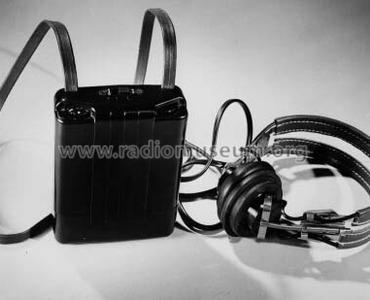Wireless Translation System
IBM; Armonk, N.Y.
- Country
- United States of America (USA)
- Manufacturer / Brand
- IBM; Armonk, N.Y.
- Year
- 1947
- Category
- Commercial Transmitter & Receiver (TRX not Amateur)
- Radiomuseum.org ID
- 323592
- Main principle
- Transceiver
- Wave bands
- Wave Bands given in the notes.
- Power type and voltage
- Line / Storage batteries (perhaps also batteries)
- Loudspeaker
- - For headphones or amp.
- Material
- Various materials
- from Radiomuseum.org
- Model: Wireless Translation System - IBM; Armonk, N.Y.
- Shape
- Very small Portable or Pocket-Set (Handheld) < 8 inch.
- Notes
-
Simultaneous Interpretation System
The IBM Wireless Translation System broadcast over seven radio channels the simultaneous translation of a speaker's remarks into as many as seven languages. The speaker's words first were carried to the headphones of interpreters who worked at microphones in booths at the sides of the meeting room. As each interpreter heard the speech, he or she translated the remarks into a second language. All translations were conveyed through the air to individual lightweight radio sets equipped with earphones and dials with which to control volume and select the language required.
As each receiver's aerial was permanently embedded in the neck strap, listeners were able to move about freely in the meeting room while listening to the translation in their own language.
Base station power supply by line AC.
Receiver with headphones powered by batteries.
- Mentioned in
- - - Manufacturers Literature (ibm.com/ibm/history/exhibits/specialprod1/specialprod1_11.html)
- Author
- Model page created by Heribert Jung. See "Data change" for further contributors.
- Other Models
-
Here you find 20 models, 20 with images and 14 with schematics for wireless sets etc. In French: TSF for Télégraphie sans fil.
All listed radios etc. from IBM; Armonk, N.Y.
Forum contributions about this model: IBM; Armonk, N.Y.: Wireless Translation System
Threads: 2 | Posts: 2
Übersetzung aus IBM Archives - Exhibits - IBM special products (vol. 1):
IBM drahtloses Übersetzungssystem
IBM-Gründer Thomas J. Watson hatte ein langjähriges persönliches Interesse an der Lösung von Problemen im Zusammenhang mit der Verwendung mehrerer Sprachen in internationalen Meetings, und er setzte die Ressourcen seines Unternehmens ein, um an der Entwicklung einer Lösung zu arbeiten. Das Endergebnis war das IBM Wireless Translation System (manchmal auch als Simultandolmetschersystem bezeichnet).
Das drahtlose Übersetzungssystem von IBM übertrug über sieben Funkkanäle die simultane Übersetzung der Ausführungen eines Redners in bis zu sieben Sprachen. Die Worte des Redners wurden zunächst auf Kopfhörer von Dolmetschern übertragen, die in Kabinen an den Seiten des Sitzungssaals an Mikrofonen arbeiteten. Während jeder Dolmetscher die Rede hörte, übersetzte er oder sie die Bemerkungen in eine zweite Sprache. Alle Übersetzungen wurden durch die Luft zu einzelnen leichten Funkgeräten übertragen, die mit Kopfhörern und Drehreglern ausgestattet waren, mit denen die Lautstärke geregelt und die gewünschte Sprache ausgewählt werden konnte.
Da die Antenne jedes Empfängers fest in das Umhängeband integriert war, konnten sich die Zuhörer frei im Sitzungssaal bewegen, während sie die Übersetzung in ihrer eigenen Sprache hörten.
Im Rahmen seiner Bemühungen um globale Verständigung und "Weltfrieden durch Welthandel" stellte Thomas Watson diese Geräte bei internationalen Treffen kostenlos zur Verfügung. Zwischen 1947 und 1953 zum Beispiel wurde das drahtlose IBM-Übersetzungssystem bei 258 internationalen Treffen in 120 Städten - von Amsterdam bis Zürich - in 34 Ländern eingesetzt.
Zu den Organisationen, die durch das drahtlose Übersetzungssystem von IBM unterstützt wurden, gehörten das Internationale Olympische Komitee, das Internationale Rote Kreuz und die Vereinten Nationen.
Heribert Jung, 24.Aug.20
IBM Archives - Exhibits - IBM special products (vol. 1):
IBM Wireless Translation System
IBM founder Thomas J. Watson had a long-standing personal interest in solving problems associated with the use of multiple languages in international meetings, and he put his company's resources to work on developing a solution. The ultimate result was the IBM Wireless Translation System (sometimes referred to as the Simultaneous Interpretation System).
As part of his efforts to bring about global understanding and "World Peace Through World Trade," Thomas Watson made this equipment available without charge to international meetings. Between 1947 and 1953, for example, the IBM Wireless Translation System was used in 258 international meetings in 120 cities -- from Amsterdam to Zurich -- in 34 countries.
Among the organizations supported by IBM's Wireless Translation System were the International Olympic Games Committee, International Red Cross and the United Nations.
Wikipedia:
Interpreting Device
Despite the extensive trial and error, without the interpretation system the trials would not have been possible and in turn, revolutionized the way multilingual issues were addressed in tribunals and conferences.
Today, all major international organizations, as well as any conference or government that uses more than one official language, uses extempore simultaneous interpretation. Notable bodies include the Parliament of Kosovo with three official languages, the Parliament of Canada with two official languages, the Parliament of South Africa with eleven official languages, the European Union with twenty-four official languages, and the United Nations with six official working languages.
Heribert Jung, 24.Aug.20
